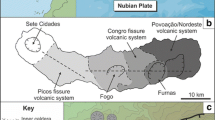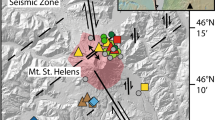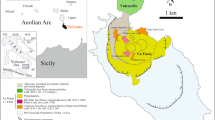Abstract
A wide variety of rock types are present in the O'Leary Peak and Strawberry Crater volcanics of the Pliocene to Recent San Francisco Volcanic Field (SFVF), AZ. The O'Leary Peak flows range from andesite to rhyolite (56–72 wt % SiO2) and the Strawberry Crater flows range from basalt to dacite (49–64 wt % SiO2). Our interpretation of the chemical data is that both magma mixing and crustal melting are important in the genesis of the intermediate composition lavas of both suites. Observed chemical variations in major and trace elements can be modeled as binary mixtures between a crustal melt similar to the O'Leary dome rhyolite and two different mafic end-members. The mafic end-member of the Strawberry suite may be a primary mantle-derived melt. Similar basalts have also been erupted from many other vents in the SFVF. In the O'Leary Peak suite, the mafic end-member is an evolved (low Mg/(Mg+ Fe)) basalt that is chemically distinct from the Strawberry Crater and other vent basalts as it is richer in total Fe, TiO2, Al2O3, MnO, Na2O, K2O, and Zr and poorer in MgO, CaO, P2O5, Ni, Sc, Cr, and V. The derivative basalt probably results from fractional crystallization of the more primitive, vent basalt type of magma. This evolved basalt occurs as xenolithic (but originally magmatic) inclusions in the O'Leary domes and andesite porphyry flow. The most mafic xenolith may represent melt that mixed with the O'Leary dome rhyolite resulting in andesite preserved as other xenoliths, a pyroclastic unit (Qoap), porphyry flow (Qoaf) and dacite (Darton Dome) magmas. Thermal constraints on the capacity of a melt to assimilate (and melt) a volume of solid material require that melt mixing and not assimilation has produced the observed intermediate lavas at both Strawberry Crater and O'Leary Peak. Textures, petrography, and mineral chemistry support the magma mixing model. Some of the inclusions have quenched rims where in contact with the host. The intermediate rocks, including the andesite xenoliths, contain xenocrysts of quartz, olivine and oligoclase, together with reversely zoned plagioclase and pyroxene phenocrysts. The abundance of intermediate volcanic rocks in the SFVF, as observed in detail at O'Leary Peak and Strawberry Crater, is due in part to crustal recycling, the result of basalt-driven crustal melting and the subsequent mixing of the silicic melts with basalts and derivative magmas.
Similar content being viewed by others
References
Allegre CJ, Minster JF (1978) Quantitative models of trace element behavior in magmatic processes. Earth Planet Sci Lett 38:1–25
Arculus RJ (1987) The significance of source versus process in the tectonic controls of magma genesis. J Volcan Geotherm Res 32:1–12
Arculus RJ, Wills KJA (1980) The petrology of plutonic blocks and inclusions from the Lesser Antilles arc. J Petrol 21:743–799
Bacon CR (1986) Magmatic inclusions in silicic and intermediate volcanic rocks. J Geophys Res 91:6091–6112
Bladh KL (1980) Rapakivi texture from the O'Leary Porphyry, Arizona (USA). Bull Volcanol 43-1:155–171
Bowen NL (1928) The evolution of the igneous rocks. Dover, New York, 334 pp
Carmichael ISE (1964) The petrology of Thingmuli, a Tertiary volcano in eastern Iceland. J Petrol 5:435–460
Christiansen RL, Lipman PW (1972) Cenozoic volcanism and plate-tectonic evolution of the western United States: II Late Cenozoic. Phil Trans R Soc London A 271:269–286
Damon PE, Shafiqullah M, Levanthal JS (1974) K-Ar chronology for the San Francisco volcanic field and rate of erosion of the Little Colorado River. In: Karlstrom TNV, Swann GA, Eastwood RL (eds) Geology of Northern Arizona, with notes on archaeology and paleoclimate; Pt I, Regional studies. Geol Soc Am Rocky Mountain Sec Mtg, Flagstaff, Ariz, pp 221–235
DePaolo DJ (1981) Trace element and isotopic effects of combined wallrock assimilation and fractional crystallization. Earth Planet Sci Lett 53:189–202
Dickinson WR, Snyder WS (1979) Geometry of subducted slabs related to San Andreas transform. J Geology 87:609–627
Eichelberger JC (1975) Origin of andesite and dacite: evidence of mixing at Glass Mountain in California and at other circum-Pacific volcanoes. Geol Soc Am Bull 86:1381–1391
Eichelberger JC (1978) Andesite volcanism and crustal evolution. Nature 275:21–27
Everson JE (1979) Regional variation in the lead isotopic characteristics of late Cenozoic basalts from the southwestern United States. Unpub PhD dissertation, Cal Inst Tech, 452 pp
Gill JB (1981) Orogenic andesites and plate tectonics. Springer, New York Berlin Heidelberg, 390 pp
Grove TL, Baker MB (1984) Phase equilibrium controls of the tholeiitic versus calc-alkaline differentiation trends. J Geophys Res 89:3253–3274
Grove TL, Gerlach DC, Sando TW (1982) Origin of calc-alkaline series lavas at Medicine Lake volcano by fractionation, assimilation, and mixing. Contrib Mineral Petrol 80:160–182
Gust DA, Arculus RJ (1986) Petrogenesis of alkalic and calcalkalic volcanic rocks of Mormon Mountain Volcanic Field, Arizona. Contrib Mineral Petrol 94:416–426
Harvey PK, Taylor DM, Hendry RD, Bancroft F (1973) An accurate fusion method for the analysis of rocks and chemically related materials by X-Ray fluorescence spectrometry. X-Ray Spectrom 2:33–44
Hildreth W (1981) Gradients in silicic magma chambers: implications for lithospheric magmatism. J Geophys Res 86:10153–10192
Huebner JS, Turnock AC (1980) The melting relations at 1 bar of pyroxenes composed largely of Ca-, Mg-, and Fe-bearing components. Am Mineral 65:225–271
Irvine TN, Baragar WRA (1971) A guide to the chemical classification of the common volcanic rocks. Can J Earth Sci 8:543–548
Keating S, Arculus RJ (1986) The assemblage opx-cpx-plag-spinel as a reliable geobarometer for igneous and metamorphic rocks. (abstract) Geol Soc Am Abstr Prog 18:652
Langmuir CH, Bender JF, Bence AE, Hanson GN (1977) Petrogenesis of basalts from the FAMOUS area: mid-Atlantic ridge. Earth Planet Sci Lett 36:133–156
Langmuir CH, Vocke RD, Jr, Hanson GN (1978) A general mixing equation with applications to Icelandic basalts. Earth Planet Sci Lett 37:380–392
LeBas MJ, LeMaitre RW, Streckeisen A, Zanettin B (1986) A chemical classification of volcanic rocks based on the total alkali-silica diagram. J Petrol 27:745–750
LeMaitre RW (1981) Genmix — a generalized petrological mixing model program. Computers and Geosciences 7:229–247
Lindsley DH (1983) Pyroxene thermometry. Am Mineral 68:477–493
Lipman PW (1975) Evolution of the Platoro caldera complex and related volcanic rocks, southeastern San Juan Mountains, Colorado. US Geol Surv Prof Paper 852 128 pp
MacDonald GA (1968) Composition and origin of Hawaiian lavas. Geol Soc Am Mem 116:477–552
MacDonald GA, Katsura T (1964) Chemical composition of Hawaiian lavas. J Petrology 5:82–133
Moore RB, Ulrich GE, Wolfe EW (1974) Geology of the eastern and northern parts of the San Francisco volcanic field, Arizona. In: Karlstrom TNV, Swann GA, Eastwood RL (eds) Geology of Northern Arizona, with notes on archaeology and paleoclimate; Pt II, Area studies and field guides. Geol Soc Am Rocky Mountain Sec Mtg, Flagstaff, Ariz, pp 465–494
Moore RB, Wolfe EW (1976) Geologic map of the eastern San Francisco volcanic field, Arizona. Miscellaneous Investigation Series, US Geol Surv, Map I–953
Moore RB, Wolfe EW (1987) Geologic map of the east part of the San Francisco Volcanic Field, north-central Arizona. Miscellaneous Field Studies, US Geol Surv, Map MF-1960
Moore RB, Wolfe EW, Ulrich GE (1976) Volcanic rocks of the eastern and northern parts of the San Francisco Volcanic Field, Arizona. US Geol Surv J Res 4:549–560
Newhall CG, Ulrich GE, Wolfe EW (1987) Geologic map of the southwest part of the San Francisco Volcanic Field, northcentral Arizona. Miscellaneous Field Studies, US Geol Surv, Map MF-1958
Norrish K, Chappell BW (1967) Physical methods in determinative mineralogy. J Zussman (ed) Chap 4 Academic Press, New York
Norrish K, Hutton JT (1969) An accurate X-ray spectrographic method for the analysis of a wide range of geologic samples. Geochim Cosmochim Acta 33:431–453
Pushkar P, Stoeser DB (1975) 87Sr/86Sr ratios in some volcanic rocks and some semifused inclusions of the San Francisco volcanic field. Geology 3:669–671
Quilivan WD, Byers FM Jr (1977) Chemical data and variation diagrams of igneous rocks from the Timber Mountain-Oasis Valley caldera complex, southern Nevada. US Geol Surv Open File Rep 77–724, pp 9
Robinson HH (1913) The San Franciscan Volcanic Field, Arizona. US Geol Surv Prof Paper 76
Sakuyama M (1981) Petrological study of the Myoko and Kurohime volcanoes, Japan: crystallization sequence and evidence for magma mixing. J Petrol 22:553–583
Smiley TL (1958) The geology and dating of Sunset Crater, Flagstaff, Arizona, in New Mexico. Geol Soc 9th Field Conf, Guidebook of the Black Mesa Basin 186–190 pp
Sparks RSJ, Marshall LA (1986) Thermal and mechanical constraints on mixing between mafic and silicic magmas. J Volcan Geotherm Res 29:99–124
Spencer KJ, Lindsley DH (1981) A solution model for coexisting iron-titanium oxides. Am Mineral 66:1189–1201
Stoeser DB (1974) Xenoliths of the San Francisco volcanic field, northern Arizona. In: Karlstrom TNV, Swann GA, Eastwood RL (eds) Geology of Northern Arizona, with notes on archaeology and paleoclimate; Pt II, Area studies and field guides. Geol Soc Am Rocky Mountain Sec Mtg, Flagstaff, Ariz, pp 530–545
Stormer JC, Jr (1983) The effects of recalculation on estimates of temperature and oxygen fugacity from analyses of multicomponent iron-titanium oxides. Am Mineral 68:586–594
Tanaka KL, Shoemaker EM, Ulrich GE, Wolfe EW (1986) Migration of volcanism in the San Francisco volcanic field, Arizona. Geol Soc Am Bull 97:129–141
Taylor HP, Jr (1980) The effects of assimilation of country rocks by magmas on 18O/16O and 87Sr/86Sr systematics in igneous rocks. Earth Planet Sci Lett 47:243–254
Tuttle OF, Bowen NL (1958) Origin of granite in the light of experimental studies in the system NaAlSi3O8-KAlSi3O8-SiO2-H2O. Geol Soc Am Mem 74
Ulrich GE, Bailey NG (1987) Geologic map of the SP Mountain part of the San Francisco Volcanic Field, north-central Arizona. Miscellaneous Field Studies, US Geol Surv, Map MF-1956
Watson EB (1979) Zircon saturation in felsic liquids: experimental results and applications to trace element geochemistry. Contrib Mineral Petrol 70:407–419
Wenrich-Verbeek KJ (1979) The petrogenesis and trace-element geochemistry of intermediate lavas from Humphreys Peak, San Francisco Volcanic Field, Arizona. Tectonophysics 61:103–129
Wolfe EW, Ulrich GE, Newhall CG (1987) Geologic map of the northwest part of the San Francisco Volcanic Field, northcentral Arizona. Miscellaneous Field Studies, US Geol Surv, Map MF-1957
Wolfe EW, Ulrich GE, Holm RF, Moore RB, Newhall CG (1987) Geologic map of the central part of the San Francisco Volcanic Field, north-central Arizona. Miscellaneous Field Studies, US Geol Surv, Map MF-1959
Yoder HS (1968) Experimental studies bearing on the origin of anorthosite. In: YW Isachesen (ed) Origin of anorthosite and related rocks. University of the State of New York, Albany, p 13–23
Author information
Authors and Affiliations
Rights and permissions
About this article
Cite this article
Bloomfield, A.L., Arculus, R.J. Magma mixing in the San Francisco Volcanic Field, AZ. Contr. Mineral. and Petrol. 102, 429–453 (1989). https://doi.org/10.1007/BF00371086
Received:
Accepted:
Issue Date:
DOI: https://doi.org/10.1007/BF00371086




